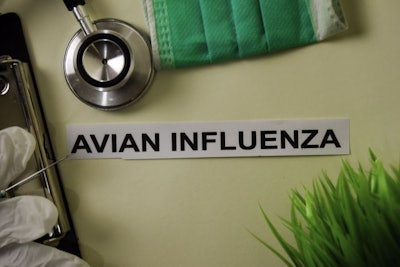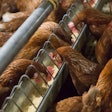
In France, the current wave of highly pathogenic avian influenza (HPAI) has spread to an 11th region of the country, as the number of confirmed outbreaks passes 200.
As of December 10, 2,174 HPAI outbreaks have been recorded in commercial poultry flocks across Europe so far this year. This is based on the latest update of the Animal Disease Information System by the European Commission (EC).
To date, one or more outbreaks have occurred in 24 countries covered by the EC since the start of 2022. The latest nation to confirm HPAI in poultry this year was Cyprus at the start of December.
Entering the last month of 2022, this year’s total outbreaks across Europe well exceeds the 1,756 outbreaks registered with the EC by 24 of the continent’s states for the whole of last year.
Based on information from the EC, mainland France has reported by far the highest number of HPAI outbreaks in poultry to the EC (1,502). This is 84 more than on November 25. Next come Hungary (287), and Germany (92).
France records 201 HPAI outbreaks in poultry this season
The latest information from the agriculture ministry puts the total outbreaks on poultry farms so far this season at 201. This was the status on December 16, and covers the current 2022-2023 season, which started on August 1. It represents a marked increase in the spread of the infection from the total of 81 outbreaks reported at the end of November.
First cases have been confirmed by the ministry recently in Saône-et-Loire. This department is located in the eastern region of Bourgogne-Franche-Comté, and means that the disease has been confirmed in 11 of the nation’s 12 mainland regions over the past four months.
Up to early December, 1,532 HPAI outbreaks linked to the H5N1 virus serotype had been confirmed in France since November of 2021. This is according to official notifications to the World Organisation for Animal Health (WOAH). These have directly impacted more than 18 million of the country’s commercial poultry through mortality or culling.
Most effective way to protect poultry against HPAI transmission from wild birds is by indoor confinement combined with high biosecurity, according to a recent opinion from the French food safety and veterinary agency, ANSES. In the light of France’s ongoing struggle to control HPAI for a third consecutive season, the ministry had requested the agency to review the options. Among the focus areas were adaptations of mandatory housing for organic and label poultry, and during the summer, when confinement could have adverse impacts on bird health and welfare.
Following the expert opinion, the ministry will require chickens, guinea fowl and turkeys to be confined in houses during the period of highest risk (November to March) in most areas. Between May and September, broiler chickens will be allowed access from 8 weeks instead of 10 weeks.
Furthermore, the ministry has announced a further study into the role of free-range poultry farms in the circulations of HPAI, and trials into better practical methods of managing the avian flu risk on farms.
Spike in German outbreaks blamed on poultry shows
At least three poultry shows in Germany have been linked to a sharp rise in HPAI outbreaks in small flocks in several regions. This is according to the national veterinary reference laboratory, Friedrich-Loeffler Institute (FLI). In particular, FLI refers to recent events involving pedigree poultry and hobby owners in Mecklenburg-West Pomerania and Thuringia.
As well as urging owners of all sizes of poultry flock to take care with biosecurity, the FLI recommends that all poultry shows in Germany are suspended until further notice.
Over the period December 1-16, FLI reported HPAI-positive tests in more than 60 domestic poultry (including chickens, ducks, and geese). Form this source, it is unclear whether the birds were from commercial or hobby flocks but the cases represent a sudden spreading of the infection across the country. Recent virus-positive cases were detected in the states of Brandenburg, Hesse, Lower Saxony, Mecklenburg-West Pomerania, North Rhine-Westphalia, Rhineland-Palatinate, Saxony, Saxony-Anhalt, and Schleswig-Holstein.
HPAI developments elsewhere in Europe’s commercial poultry
The Czech Republic has registered its first HPAI outbreak of the 2022-2023 season.
At the end of November, 1,235 of the around 17,800 birds died at a farm in South Bohemia (Jihocesky). Subsequently, presence of the H5N1 virus serotype was confirmed, and the remaining birds were culled. Source of the infection is reported as contact with wild species.
Since the end of November, Hungary’s veterinary authority has registered a further 33 HPAI outbreaks on commercial farms with WOAH. These include six premises in Csongrad-Csanad and the rest were in Bacs-Kiskun. In these two counties in southern Hungary, 75 outbreaks linked to the H5N1 virus serotype have been recorded since early November.
Poland’s first outbreak of the winter was confirmed by the chief veterinary office in early December. Affected was a flock of more than 219,000 laying hens in Opole. Located in the south-west of the country, this province borders the Czech Republic.
From the United Kingdom (U.K.), the agriculture department, Defra reports that the number of HPAI outbreaks in all poultry in 2022 stands at 230 (as of December 15).
Since the start of December, there have been two new confirmed outbreaks in commercial poultry in Italy. Affected were a guinea fowl breeder in Veneto, and a flock of meat ducks in Lombardy. According to European Reference Lab for avian influenza, IZSVe, these bring the nation’s total outbreaks since September to 29.
Further outbreaks in backyard flocks, captive birds
Over the past few months, the EC has included a separate category for HPAI outbreaks in captive birds. Covering non-commercial poultry flocks, zoos, and similar premises, this year’s total stands at 277 (as of December 10).
One or more cases have been confirmed in 20 European countries so far this year. In the early days of this month, Cyprus and Poland recorded their first cases of the year in this category with the EC.
With a total of 96 so far this year, France leads the region’s nations for this type of outbreak. However, the largest jump in outbreaks since November 25 was in Germany, where the total currently stands at 81. Following are the Netherlands (48), and Belgium (15). Each of the other nations registering cases in this category in 2022 has registered no more than seven outbreaks.
Not covered by the EC system, the U.K. has registered three new outbreaks in captive birds to WOAH over the past week. These occurred at a zoo, in falcons, and a backyard poultry flock in southern England.
Russia’s veterinary agency has declared to WOAH that the HPAI situation has been “resolved” in Samara. In this region of the Volga federal district, poultry in two non-commercial flocks tested positive for the H5N1 virus between July and October of this year.
European states record more cases in wild birds
For the year to December 10, a total of 3,163 HPAI outbreaks in wild birds have been reported to the EC. One or more outbreaks have now been confirmed in 33 European states in 2022. As with poultry and captive birds, Cyprus has just recently registered its first cases of the year with the EC.
Of the total, 1,217 outbreaks have been reported by Germany, followed by the Netherlands (666) and France (290).
Since November 25, totals have also increased for Belgium, Denmark, Italy, Northern Ireland, Norway, Poland, Romania, Spain, Sweden, and Switzerland.
For comparison, the EC disease system recorded a total of 2,437 HPAI outbreaks in captive and wild birds in 31 European states during the whole of 2021.
Over the past two weeks, authorities in the U.K. have registered with WOAH 79 further cases of wild birds testing positive for the H5N1 HPAI virus.
In Estonia, HPAI in wild birds linked to the H5N8 HPAI virus serotype has been “resolved.” According to the veterinary authority’s declaration to WOAH, cases tested positive for this variant at 30 locations in the country between February and the end of September last year.
View our continuing coverage of the global avian influenza situation.


















